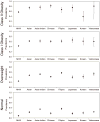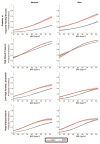Asian Americans have greater prevalence of metabolic syndrome despite lower body mass index
- PMID: 20680014
- PMCID: PMC2989340
- DOI: 10.1038/ijo.2010.152
Asian Americans have greater prevalence of metabolic syndrome despite lower body mass index
Abstract
Objective: To examine the relationship between body mass index (BMI) and metabolic syndrome for Asian Americans and non-Hispanic Whites (NHWs), given that existing evidence shows racial/ethnic heterogeneity exists in how BMI predicts metabolic syndrome.
Research design and methods: Electronic health records of 43,507 primary care patients aged 35 years and older with self-identified race/ethnicity of interest (Asian Indian, Chinese, Filipino, Japanese, Korean, Vietnamese or NHW) were analyzed in a mixed-payer, outpatient-focused health-care organization in the San Francisco Bay Area.
Results: Metabolic syndrome prevalence is significantly higher in Asians compared with NHWs for every BMI category. For women at the mean age of 55 and BMI of 25 kg m(-2), the predicted prevalence of metabolic syndrome is 12% for NHW women compared with 30% for Asians; similarly for men, the predicted prevalence of metabolic syndrome is 22% for NHWs compared with 43% of Asians. Compared with NHW women and men with a BMI of 25 kg m(-2), comparable prevalence of metabolic syndrome was observed at BMI of 19.6 kg m(-2) for Asian women and 19.9 kg m(-2) for Asian men. A similar pattern was observed in disaggregated Asian subgroups.
Conclusions: In spite of the lower BMI values and lower prevalence of overweight/obesity than NHWs, Asian Americans have higher rates of metabolic syndrome over the range of BMI. Our results indicate that BMI ranges for defining overweight/obesity in Asian populations should be lower than for NHWs.
Conflict of interest statement
Figures



References
-
- Isomaa B, Almgren P, Tuomi T, Forsen B, Lahti K, Nissen M, et al. Cardiovascular Morbidity and Mortality Associated With the Metabolic Syndrome. Diabetes Care. 2001;24:683–689. - PubMed
-
- Laaksonen DE, Lakka H-M, Niskanen LK, Kaplan GA, Salonen JT, Lakka TA. Metabolic Syndrome and Development of Diabetes Mellitus: Application and Validation of Recently Suggested Definitions of the Metabolic Syndrome in a Prospective Cohort Study. Am J Epidemiol. 2002;156:1070–1077. - PubMed
-
- National Cholesterol Education Program (NCEP) Third Report of the National Cholesterol Education Program (NCEP) Expert Panel on Detection, Evaluation, and Treatment of High Blood Cholesterol in Adults (Adult Treatment Panel III), Final Report. National Heart, Lung, and Blood Institute (NHLBI), National Institutes of Health (NIH); 2002. - PubMed
-
- Alexander CM, Landsman PB, Teutsch SM, Haffner SM. NCEP-Defined Metabolic Syndrome, Diabetes, and Prevalence of Coronary Heart Disease Among NHANES III Participants Age 50 Years and Older. Diabetes. 2003;52:1210–1214. - PubMed
-
- Han TS, Williams K, Sattar N, Hunt KJ, Lean ME, Haffner SM. Analysis of obesity and hyperinsulinemia in the development of metabolic syndrome: San Antonio Heart Study. Obes Res. 2002;10:923–931. - PubMed

